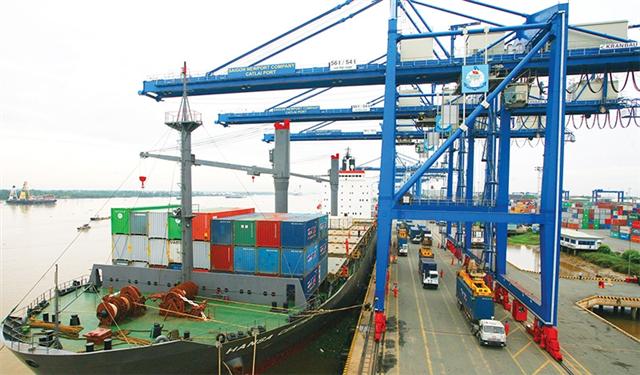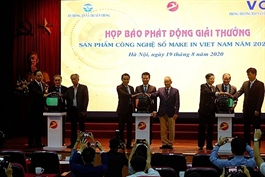Maritime service providers in request for EVFTA assistance
Maritime service providers in request for EVFTA assistance
While the EU-Vietnam Free Trade Agreement is expected to bring about huge bonanzas, Vietnamese maritime transport service giants such as Saigon Newport Corporation and Vietnam Maritime Corporation are facing an uphill battle to satisfy strict rules while seeking supporting policies from the government.

Besides the advantages that the EVFTA brings, it also forces local logistics companies, particularly in maritime trade, to up their game, Photo: Le Toan
|
Vietnam Maritime Corporation (VIMC) last week held the first general shareholder meeting to transform it into a joint-stock company, and to discuss future plans amid new advantages and stiffening competition on the back of the enforcement of the landmark EU-Vietnam Free Trade Agreement (EVFTA).
VIMC, which has a fleet of 69 vessels with total tonnage of 1.53 million, is facing some disadvantages to compete with foreign rivals. Le Quang Trung, deputy general director, said that VIMC and other shipping firms have age-old vessels and so are further away from meeting the strict regulations of seaports in the bloc.
“With the existing vessels, we find it hard to gain the advantages to win import-export orders into the European Union. This requires us and other shipping firms to focus investment in maintenance to satisfy high technical requirements by EU seaports,” Trung admitted.
VIMC, which is also a powerful seaport operator, also needs to improve the service quality of seaports and logistics to adapt to the EVFTA commitments. The giant now has stakes in 16 seaports nationwide with 80 berths, accounting for over 23 per cent of the country’s total number of piers and 30 per cent of total piers length.
Similarly, Saigon Newport Corporation is concerned about possible problems for Vietnamese businesses from technical barriers, labour resources, pressures to compete with EU goods, trade remedy measures, quality, and regulations on environmental protection.
A representative of Saigon Newport Corporation said, “The EVFTA can affect logistics development prospects in two aspects: opening markets in the field of transport and transport-related services; and commitments in areas affecting logistics service market capacity in terms of scale, service quality, demand for capacity expansion, and service performance.”
Vietnamese maritime service providers like Saigon Newport Corporation will be hit by the EVFTA commitment on consolidation and redistribution of empty containers. The EU’s international maritime transport services are allowed to provide the service on the Quy Nhon-Cai Mep route immediately after enforcement before expanding to all routes in the following five years.
“This is expected to create competition for Vietnamese shipping lines that were so far monopolised on inland shipping services,” noted the representative, adding, “In the dredging service, Vietnam permits EU businesses to set up joint ventures of up to 51 per cent to provide services in Vietnam.”
To enable domestic players to gain a competitive edge, the two giants have urged the government to take concrete action soon. Trung proposed that the government adjust the import duty, cut fees, and increase the minimum handling service for import-export containers at Haiphong, Lach Huyen, and Cai Mep-Thi Vai ports by 10 per cent from early 2021 to gradually bring it on par with regional ones.
“The government should reduce the import duty for spare parts that Vietnam is not able to produce at home, or those made locally but yet to receive recognition from international registration organisations while reducing personal income tax for the crew,” Trung of VIMC said.
“We also need the supporting policies on maritime fees and shipping charges, allowing vessels of 50,000 gross register tonnage to enjoy a reduction of 40 per cent in fees in comparison with those at other areas starting from January 1, 2021,” he elaborated. “Regarding customs procedures, supporting policy for goods in transit among seaports in the Cai Mep-Thi Vai port area should also be built.”
Meanwhile, Saigon Newport Corporation proposed concentrating on port service price adjustment and development of transport links between seaports and industrial zones, other means of transport, and port-centric logistics.
“The country should adjust port service prices to suit the investment scale and development needs of each kind of seaport, quickly approaching the average price in the region because the current prices of seaport services, especially container handling and towage rates applied at Vietnamese seaports, are much lower than other Southeast Asian nations, preventing losses for local seaports,” the representative suggested.
“Ministries and agencies should have more concrete solutions to attract investment in the development of inland container depots, inland waterway wharfs, logistics centres, and specialised barge berths to increase their capacity, thus easing pressures on roads,” he added.
If all the problems are solved, VIMC and Saigon Newport Corporation are expected to fully benefit from the EVFTA thanks to growing logistics demands driven by the deal, which took effect on August 1.
The EU is currently one of Vietnam’s largest trading partners. Every year, EU ports unload around four billion tonnes of cargo, in which the biggest profit comes from big seaports. Transport accounts for 46 per cent of the total market value of logistics, while warehousing 11 per cent and other logistics services 43 per cent.
According to a study from the Ministry of Planning and Investment conducted last year, the EVFTA is expected to raise Vietnam’s exports to the EU by an extra 20 per cent in 2020, 42.7 per cent by 2025, and 44.37 per cent in 2030. In the meantime, the country’s imports from the EU will also rise by an extra 15.28 per cent in 2020, 33.06 per cent in 2025, and 36.7 per cent in 2030.
|
Jean-Jacques Bouflet - Vice chairman, EuroCham The EVFTA is a strong vote of confidence in Vietnam from the EU. The fact that this is just the second such deal agreed with an ASEAN member state shows the high regard with which the EU holds Vietnam, its positive record of reform, and its strategic importance in Asia. Before the EVFTA had been ratified, 74 per cent of European business leaders said that the agreement would have a positive impact on their business operations in the short-term. Over the long-term, that figure rises to over 90 per cent. Of course, the trade deal will benefit all sectors and industries. However, it will be of particular importance to maritime trade – since an increased trade in goods cannot happen without transport networks, supply chains, and logistics infrastructure; or, indeed, without the companies who facilitate them. Now the relationship between our two sides will grow stronger than ever as we seek to unlock the full potential of this historic free trade agreement. Nguyen Tuong - Deputy secretary general, Vietnam Logistics Business Association Vietnam’s maritime transport companies are hardly able to compete with EU rivals in cargo transportation because most of the the small size of their container vessels. Moreover, Vietnamese firms in this field will face competition in the redistribution of empty containers which opens widely to businesses from the bloc under the EVFTA. The competition will stiffen more when foreign rivals can approach from all routes in the following five years. The proposal to cut and adjust the import duty, cut fees, and increase the minimum handling services for import-export containers at Haiphong will not help Vietnamese firms much in this competition. They should instead focus on the development of inter-Asian routes to gain advantages. Nguyen Son Tra - Department of Multilateral Trade Policy, Ministry of Industry and Trade The EVFTA contributes to diversifying markets for Vietnam. It, however, will give some possible challenges to local firms, including those in the maritime transport industry. Vietnam’s commitments to open the market to goods and services from the EU will pressurise the economy and businesses. The EVFTA is also a chance, forcing Vietnamese firms to increase their competitiveness. Vietnamese businesses should build long-term plans and strategies, as well as increase technology application to improve capacity and competitiveness. They should also well prepare for possible disputes on trade remedies. |
























